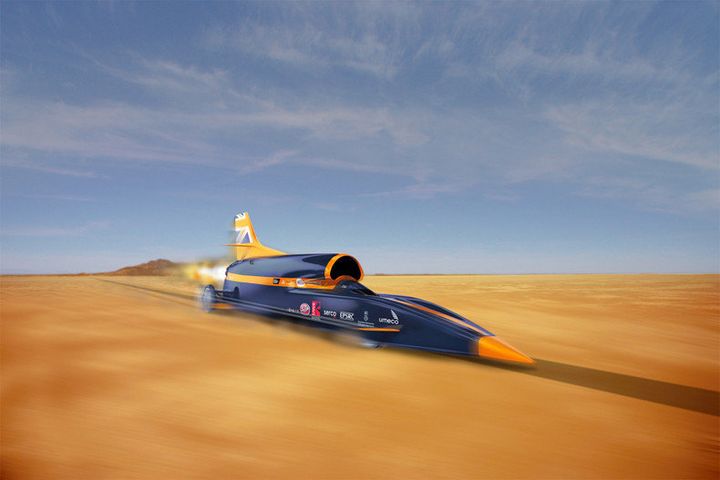
By Jim Nash
An English racing team called the Bloodhound Project is a step closer to breaking the land-speed record—not just by 150 or even 300 kilometers (100 or 200 miles) per hour. The English team—the favorite to succeed in a field of at least five competitors—successfully tested a rocket in early October that is expected to help push its car to 1,600 kph (1,000 mph), nearly 500 kph (300 mph) faster than the previous mark.
The rocket is a hybrid. It burns when a liquid oxidizer—in this case highly concentrated peroxide—contacts a solid fuel, here a synthetic rubber called hydroxyl-terminated polybutadiene, in a chamber. During the October test—its first—the engine performed as expected, igniting for 10 seconds and creating 6,350 kilograms (14,000 pounds) of thrust, equivalent to about 35,000 horsepower.
The Bloodhound's four-meter- by 45.7-centimeter-diameter hybrid rocket will be joined with a Cosworth Formula 1 engine that pumps liquid oxidizer into the rocket and a EuroJet EJ200 military jet engine on loan from the U.K. They plan to push the Bloodhound Super Sonic Car to Mach 1.4 in South Africa a year from now.
Even as Bloodhound scientists and engineers pored over data from the test burn, competitors around the world continued their efforts to break the 15-year-old record of 1,228 kph (763.035 mph), or Mach 1.02. Andy Green, a Royal Air Force fighter pilot and, not coincidentally, Bloodhound's designated driver, holds that record.
"We were sealed in a control bunker about 200 yards [180 meters] away" from a second sealed bunker with the rocket at a Cornwall, England, airport, Green says. "I could feel it through the ground. You could smell the fuel. It was the smell of success."
In addition to breaking the land-speed record, a 1,600 kph (1,000-mph) run would be faster than any jet fighter at low altitude in history, Green says. The fastest pass—at more than 15 meters off the ground—was about 1,590 kph (988.3 mph), in a modified Lockheed F-104 in 1977, he adds, "and that was without dragging its wheels."
Out on South Africa's Hakskeen Pan, the rocket will have to produce a peak thrust of 27,500 pounds over 20 seconds. The EJ200 jet engine will chip in another 20,000 pounds of thrust. Together they will create a total of 135,000 horsepower.
Why is Green pairing a jet engine with a rocket? Money is the chief constraint for this sport, even when you have the English military lending you a free-of-charge jet engine. "Going with just a rocket would double our budget," Green says.
Adding a conventional jet engine enables the Bloodhound team to begin testing the vehicle next summer up to 1,125 kph (700 mph) without sparking the rocket. In fact, 90 percent of the testing on the chassis, suspension, body and brakes does not require the rocket, according to Green.
Operationally, the Bloodhound rocket "is fully throttleable," Green says. That is, it fires up when the oxidizer pump comes on and quits when the flow halts, making it more reliable and controllable than designs in which you light a fuse and hope for the best.
Bloodhound may be behind in development compared with some rivals, but government support, Green's presence and that of former land-speed record-holder Richard Noble as project director make them the team to beat.
Meanwhile, in the desert east of Los Angeles, Waldo Stakes, chief executive of California-based Bloodhound competitor Land Speed Research Vehicles, is designing the Sonic Wind, a car he says will crack 3,200 kph (2,000 mph). His economy-class effort involves systems every bit as exotic as those being used in the Bloodhound Project. His propulsion will come from a junked XLR-99 rocket engine built in the 1960s to power the now-defunct X-15 hypersonic research rocket plane. The engine once generated 500,000 horsepower. The sport of land-speed racing is at the point "where we need a lot of power to push a car through this dense syrup of air," Stakes says.
Stakes is not the only competitor of the four-year-old Bloodhound Project. There are two in Australia, one in New Zealand and a privately funded Canadian-American team in Washington State focused on "merely" topping 1,290 kph (800 mph). Ed Shadale, principal owner and driver of North American Eagle, says he is not intimidated by Bloodhound, which does not yet have a chassis. (Assembly of Bloodhound’s chassis should begin by yearend.)
The Eagle's chassis is a rehabbed F-104 jet fuselage that has completed 31 test runs. Shadale's vehicle, like all the contenders, looks like a colorful missile on its side, with one exception. Rather than being streamlined to the point of anorexia, the Eagle is pitched steeply on its nose and stabilized by a wide, outrigger-style rear axle.
The Eagle's top speed will be 1,340 kph (835 mph), and it has gone about 965 kph (600 mph). "Technically, we're in great shape," Shadale says, adding, "Financially…"
Neither the Bloodhound nor Eagle will race on the western U.S.'s storied salt flats, and for the same reason: Where the pans have not been damaged by recreational use, they are thinning to a less than eight-centimeter veneer in places. Imperfections rob horsepower and are dangerous.
"We've found 11 really beautiful miles" [17.7 kilometers] of alkali lake bed in southeast Oregon's Alvord Desert. "We need 14 or 15 miles [about 24 kilometers], really," Shadale says, which means focusing on immediate horsepower.
Stakes is sticking with the U.S., home of many speed records. He says he will overcome the horsepower-robbing imperfections of native flats by throwing more power at the problem.
"Here's how I see it: The North American Eagle will break the record, then the U.K., then I come in and bat cleanup," Stakes says.
He might be the only one in the world who sees this race in such straightforward terms.
